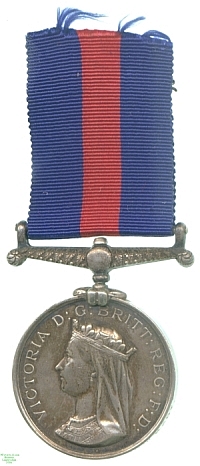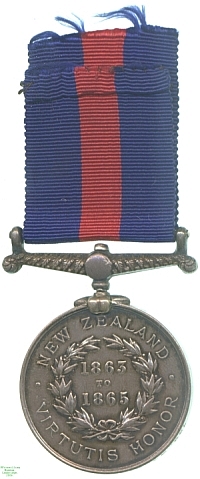
Obverse, a bust of Queen Victoria with veil

Reverse, laurel wreath within the inscription

Obverse, a bust of Queen Victoria with veil |

Reverse, laurel wreath within the inscription |
The New Zealand Medal was instituted in 1869 to recognise service in the New Zealand Wars of 1845-46, 1847 and 1860-66, though not for any of the other conflicts in that or a wider period in the islands. The phrase New Zealand Wars covers a variety of affrays, whose common factors were relatively few beyond that all, at some level, involved government forces suppressing risings by the indigenous Maori peoples. The background to the conflicts was misunderstandings and lapses, more or less wilful from case to case, in the implementation of the Treaty of Waitangi by which in 1840 the newly-instituted New Zealand government had protected the Maori tribes from loss of their lands. Not all the conflicts for which the New Zealand Medal was awarded were of this kind, however, some rather being wars between Maori tribes in which one side had managed to engage the government.
There were twenty-eight different sorts of New Zealand Medal awarded, of which twenty-seven bore the dates of different periods of service, some of which overlapped or enveloped the periods of other issues. There was also an undated medal issued for those whose service dates were no longer recorded, which might serve for any of the other twenty-seven.
The dates on this medal relate to a pair of conflicts known as the Waikato Invasion and the Taurange Campaign. The need to deal with the centralised colonial administration of the settlers in New Zealand had influenced some of the Maori tribes to move towards a confederate structure of rule themselves with a single head; this party, the King Movement, came to be led by King Tawhiao of the Tainui tribe. The New Zealand administration recognised that this posed a considerable threat to their ability to arrange matters in the islands, and by 1863 sufficient forces had been assembled to carry out a definitive assault on the confederacy's heartlands in the Waikato. The invasion proceeded slowly, with few definitive results, and considerable dissatisfaction on the part of the British officer commanding, General Sir Duncan Cameron, who saw the campaign as a use of British troops to steal Maori land. The Maoris could afford their losses less easily than the British, however, and by 1864, despite considerable aid from other tribes, the Waikato chiefs were forced to a last stand at Orakau. The British massacred some of the defenders but many escaped and events elsewhere in New Zealand led the British to agree a cease-fire. The King Movement remained effectively undefeated.
The events that had led to the Waikato ceasefire were attacks on British forces at Tauranga in the North Island, where they had been sent to deter the support coming thence to the Waikato. Here again, and this time despite opposition to their enemies from other Maori tribes, large numbers of British forces were repeatedly defeated by small numbers of Maoris using ambush tactics and highly effective bush fortresses (pahs). One decisive British victory in the field at Te Ranga allowed negotiations to be opened and the British then withdrew most of their troops to the South Island where fighting had now broken out at Wanganui in what would be the Second Taranaki War.
This conflict was distinguished from the still-ongoing fighting of previous wars by the new presence of the religious movement known as the Pai Marire, or, when taken to the battlefield against the wishes of their pacifist prophet Te Ua, the Hau Hau. Although their early beliefs of invulnerability were quickly dashed, the new mass attacks they adopted (often resisted by non-believing Maori as much as colonialists) presented a worrying threat. Governmental response to this was fragmented, as Cameron and his men, backed by the British government in London, were resistant to what they increasingly saw as a land-grab despite the urging of their superiors in Auckland. Fighting continued desultorily through 1865, with the British military only committing to battle when they had either a manifestly superior position or Maori support.
This medal was awarded to Private William Bourke of the 70th Regiment. Lester Watson purchased the medal from the dealer Lowe at some point before 1928.